2 福建师范大学地理科学学院, 福建 福州 350007;
3 福州市文物考古工作队, 福建 福州 350001;
4 福建博物院, 福建 福州 350025)
中国是世界主要的农业起源中心之一[1~3],位于北方的黄河流域和南方的长江流域分别被认为是世界上旱作农业和稻作农业重要的起源地区之一[4~6]。水稻在距今1万年左右在长江中下游地区开始驯化[7~9],随后向南向北传播,在约距今8000年左右北传至黄河和淮河流域,与这些区域原有的旱作农业一起形成了稻旱混作的农业格局[10~17]。最近有关稻作农业南传的研究结果表明,在约5000年前左右到达福建,最晚也于4000年前到达广东[18](图 1)。但关于旱作农业南传,特别是向东南传播的路线及时间不是很确定,稻旱混作农业格局在该区域发生和发展的过程也不是非常清楚。
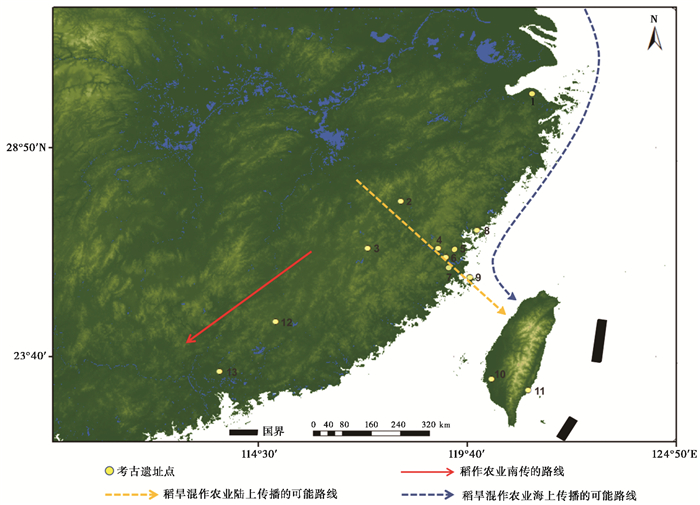
|
图 1 文中所提到的考古遗址的位置及稻旱混作南传的可能路径(据文献[18, 28]改绘) 1.河姆渡(Hemudu);2.葫芦山(Hulushan);3.南山(Nanshan);4.大坪顶(Dapingding);5.昙石山(Tanshishan);6.白头山(Baitoushan);7.庄边山(Zhuangbianshan);8.黄瓜山和屏风山(Huangguashan & Pingfengshan);9.壳丘头(Keqiutou);10.南关里东(Nanguanli East);11.潮来桥(Chaolaiqiao);12.老院(Laoyuan);13.茶岭(Chaling) Fig. 1 Location of archaeological sites mentioned in the text and the possible routes of mixed rice and millet farming dispersal(modified from references[18, 28]) |
闽江下游地区是稻作和旱作农业传至台湾及东南亚地区的关键节点[19~20],该区域的新石器时代从早到晚依次出现约6000~5500 cal. a B.P.的壳丘头文化(壳丘头遗址)[21~23]、5500~5000 cal. a B.P.的昙石山下层文化(昙石山下层)[23]、5000~4300 cal. a B.P.的昙石山文化(昙石山中层、庄边山下层)[23~25]、4300~3500 cal. a B.P.的黄瓜山文化(庄边山上层、黄瓜山遗址)等[26~28](图 1)。壳丘头遗址与福建周边地区的诸多考古学文化相联系,与之年代最相接近的是浙江河姆渡文化,壳丘头遗址均位于海岛上,目前无黍粟和水稻的发现[22]。庄边山遗址的相关研究表明古代先民于昙石山文化时期已经开始种植水稻,但该遗址尚无旱作农业成分的发现[25~26]。黄瓜山遗址和屏风山遗址年代虽然较晚,但水稻和黍粟却同时出现[27~28]。位于闽江上游武夷山东麓的南山遗址(5300~4400 cal. a B.P.)[18, 29]和台湾岛西部的南关里东遗址(约5000~4300 cal. a B.P.)[30~32]都发现了稻旱混作的农业证据(图 1),但在它们之间的闽江下游地区,目前还没有发现与之时间相近的稻旱混作农业的证据。虽然在闽江下游的黄瓜山遗址(4300~3500 cal. a B.P.)发现了稻旱农业的证据[28],但其时间较晚,如果要明确农业从福建向台湾传播的时间和过程,还需要在更早的昙石山文化遗址中发现稻旱混作的农业证据[32]。闽江下游稻旱混作农业到底是什么时候开始的?形成的过程又是怎样?昙石山文化时期是否有稻旱混作的农业结构?囿于区域考古资料和农作物鉴定方法所限,一直没有明确的答案。本文结合14C测年数据和区域考古文化序列,对闽江下游地区新石器时代白头山遗址进行了植硅体分析,以期为稻旱混作农业的南传提供新的证据。
1 材料与方法白头山遗址(26°07′50.67″N,119°09′16.36″E)位于福建省闽侯县荆溪镇白头村(图 2),地处闽江下游一处凸起于江边的低缓丘陵,地势低平且周边视野开阔,海拔约30 m,距离昙石山遗址约3 km,总面积15750 m2。2018年1月至8月因闽江大桥建设由福建博物院和福州市考古队对该遗址进行抢救性发掘,总发掘面积约1100 m2。
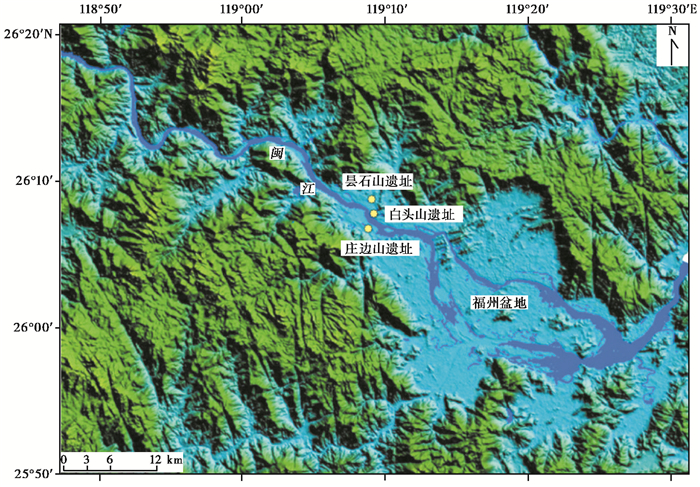
|
图 2 白头山遗址位置图 Fig. 2 Location of the Baitoushan site |
该遗址涵盖了闽江下游地区主要史前文化内涵,各个时期陶片、石器等出土器物都较为丰富,具有考古学文化的典型特征,呈现出较为明显的变化和联系。本研究中样品主要采集自白头山遗址T13探方的西壁(图 3a)和南壁(图 3b),剖面厚约200 cm左右。整个遗址文化层堆积可分为13层,第1层为现代耕土层,第2层为历史时期扰动层,第3层为青铜时代文化层,第4层为黄瓜山文化层,第5至第10层为昙石山文化层,第11至第13层为昙石山下层文化。选取第5至13层用于植硅体分析,其中第2层、第3层、第7层和第9层在T13探方的西壁和南壁缺失。在相对较厚的第5、第6和第10层加密采样,在T13探方西壁的第5层采集6个样品,在T13探方的南壁的第6层采集3个样品,在第10层采集2个样品,其余层位(第8、第11~13层)每层各采集1个样品;此外,采集了H14灰坑样品和T1007探方黄瓜山文化地层的样品各1个进行对比研究,一共采集17个样品。由于福建地区气候潮湿,酸性土壤不适宜植物遗存及木炭的保存,可用于测年的样品较少,仅在该遗址T13探方西壁第10层距地表约170 cm和东壁黄瓜山文化层灰坑距地面约150 cm的位置发现2个木炭样品,将这两个样品送往美国BETA实验室进行加速器质谱仪(AMS)放射性碳测年。
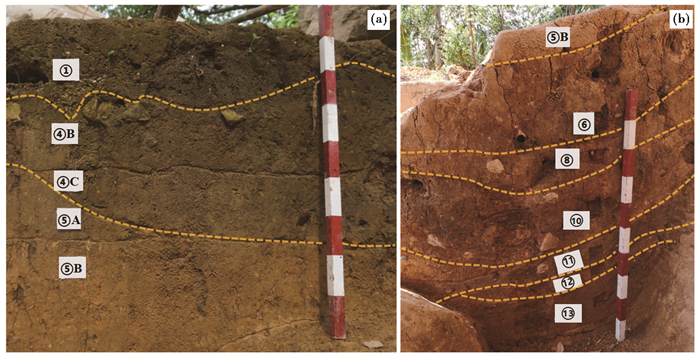
|
图 3 白头山遗址部分采样剖面图 (a)T13探方西壁;(b)T13探方南壁 Fig. 3 Parts of sampling profiles of Baitoushan site |
植硅体的提取参照传统的湿式灰化法,具体方法如下:每个样品取3 g土样,用浓度为30 %的过氧化氢(H2O2)水溶液去除有机质,用浓度为10 %的盐酸(HCl)溶液去除碳酸盐,最后用比重2.35的溴化锌(ZnBr2)重液浮选,将浮选出的植硅体用中性树胶制片,上述实验在中国科学院地质与地球物理研究所完成。植硅体的鉴定和分类参照王永吉和吕厚远[33]、Piperno[34]的研究成果。在400倍BK-POLR偏光显微镜下进行观测,统计和拍摄,每个样品至少随机统计500粒植硅体,计算各类型的百分含量。
2 研究结果2.1测年结果白头山遗址第10层(昙石山文化层)采集的炭样测年结果显示其处于4763~4686 cal. a B.P.,第4层(黄瓜山文化层)采集的灰坑样品的测年结果显示在3722~3814 cal. a B.P.(表 1)。
| 表 1 白头山遗址AMS 14C测年数据* Table 1 Results of AMS 14C dates from the Baitoushan site |
在白头山遗址的样品中共鉴定出40余类植硅体形态,统计8800余粒个体,并绘制植硅体组合百分比图谱(图 4)。常见的植硅体形态有平滑棒型、扇型、哑铃型、尖型、长鞍型、短鞍型、方型、长方型、齿型、塔型、十字型、刺球型、阔叶木本多面体型等(图 5)。在该遗址的样品中还发现了少量未知形态的植硅体,其植硅体鉴定特征尚不明确,无法判断其种属来源。
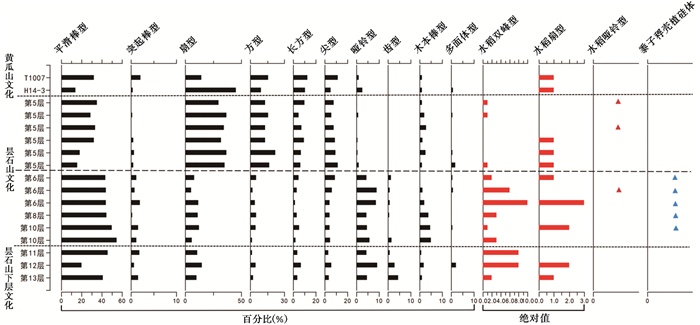
|
图 4 白头山遗址剖面植硅体组合百分比图谱 Fig. 4 Selected phytolith assemblages from the Baitoushan site |
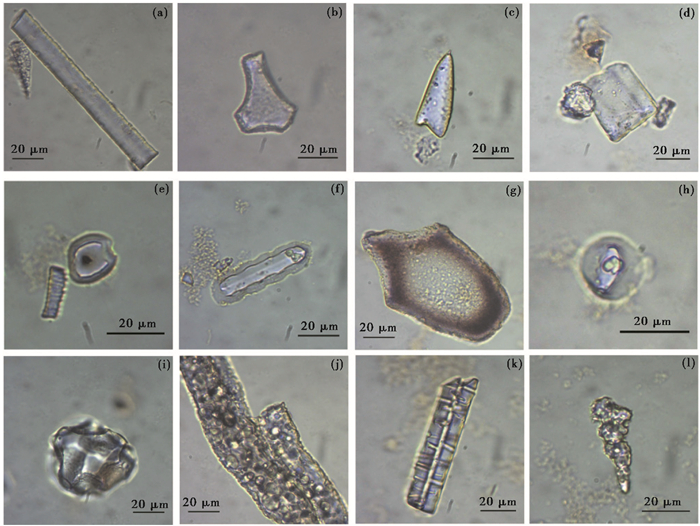
|
图 5 白头山遗址常见植硅体类型 (a)平滑棒型(Smooth-elongate);(b)扇型(Bullifrom);(c)尖型(Acicular hair cell);(d)方型(Square);(e)短鞍型(Short saddle);(f)齿型(Trapeziform sinuate);(g)盾型(Scutiform-bulliform from reed);(h)帽型(Rondel);(i)多面体型(Broadleaf-types);(j)木本型(Woody-elongate);(k)海绵骨针(Sponge spicule);(l)未知类型(unknown) Fig. 5 Images of typical phytolith morphotypes identified from the Baitoushan site |
白头山遗址的植硅体鉴定结果表明自昙石山文化下层至黄瓜山文化层平滑棒型植硅体普遍存在且含量较高,昙石山文化下层时期,扇型、方型、阔叶木本多面体型植硅体含量较低;哑铃型、齿型和尖型含量较高;昙石山文化层前半段(第6~10层),方型和扇型含量都较前一阶段增加1倍左右,木本棒型植硅体增加,哑铃型、齿型含量则略有减少;昙石山文化层后半段(第5层)直至黄瓜山文化时期,方型、扇型含量继续增加,扇型显著增加,且方型和长方型都较上一阶段明显增加,哑铃型和齿型显著减少。
前人的研究表明水稻一般具有3种特征型植硅体,即水稻颖壳双峰型植硅体、稻叶表皮机动细胞扇型植硅体和叶茎中的并排哑铃型植硅体[33, 37~39],黍子稃壳上的η型植硅体具有鉴定意义,可以与粟及狗尾草区分[40]。鉴定结果显示该遗址的样品中有较多的来自水稻的特征型植硅体和少量黍子稃壳植硅体(图 6)。
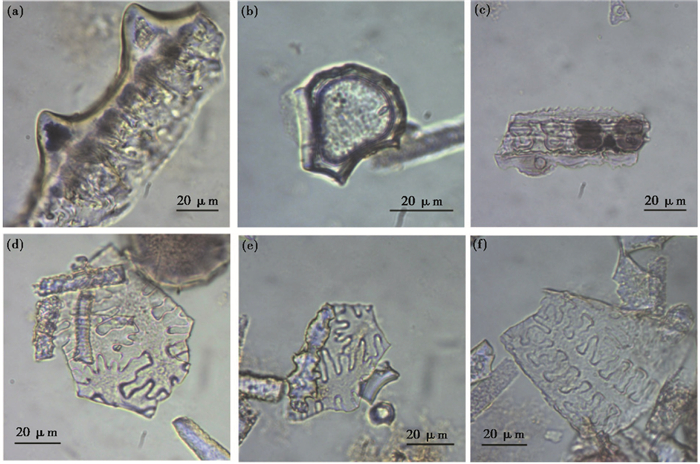
|
图 6 白头山遗址中可鉴定的农作物植硅体形态 (a)水稻双峰型(Double-peaked phytolith from rice husk);(b)水稻扇型(Rice bulliform from rice leaf);(c)并排哑铃型(Bilobates parallel from rice leaf/stem);(d~f)黍子稃壳植硅体(η-type phytolith from common millet) Fig. 6 Images of crop phytolith morphotypes identified from the Baitoushan site |
根据考古学年代和14C测年结果,白头山遗址的17个样品可划分为黄瓜山文化、昙石山文化、昙石山下层文化3组。在各时期的样品中均可观察到水稻特征型植硅体,其数量和比例呈现出明显变化。昙石山下层文化层的所有样品中均发现水稻特征型植硅体。昙石山文化层中农作物植硅体含量丰富,每个样品中都发现了水稻特征型植硅体,且在昙石山文化前半段的每个层位都有黍子稃壳植硅体的发现,共发现7粒黍子稃壳植硅体。在数量上水稻植硅体相对较多,黍子稃壳植硅体数量较少,在第6层水稻特征型植硅体含量达到峰值,某些样品在统计500粒植硅体后仍未发现黍子稃壳植硅体,但在重新扫视多张玻片后,有黍子稃壳植硅体的出现(图 4)。昙石山文化后半段文化层和黄瓜山文化层的每个样品零星可见水稻特征型植硅体,尚未发现黍子植硅体。
3 讨论 3.1 白头山遗址年代白头山遗址T13探方的文化堆积大致可分为三部分,即黄瓜山文化层、昙石山文化层和昙石山下层文化层。第4层出土陶器包含硬陶、夹砂陶、泥质橙黄陶、彩陶等,属于黄瓜山文化层,该层所采集的灰坑样品的测年结果显示在3722~3814 cal.a B.P.(表 1),与黄瓜山文化层年代(3500~4300 cal. a B.P.)相符[26~28]。第10层表现为黑褐色夹红褐色并部分参杂灰黑、黄灰色粉质粘土,质地较松软,出土物以夹砂陶占绝对多数,纹饰常见拍印纹或素面,属于昙石山文化层,昙石山文化层考古学年代为5000~4300 cal. a B.P.[23~24],取自第10层的炭样测年结果显示其处于4763~4686 cal. a B.P.(表 1),与其考古学年代相一致。白头山遗址第11至第13层属昙石山下层文化层,其中第13层为红褐色夹灰黑色粉质粘土,土质较松软,出土少量夹砂红陶,夹砂黑陶,仅见一片泥质橙红陶,器表纹饰少量拍印绳纹,多素面。结合出土器物类型的时代特征及区域考古文化序列,昙石山下层文化年代在5500~5000 cal. a B.P.之间[23],可推测白头山遗址第13层年代要早于昙石山文化,大概在5000 cal. a B.P.左右,所以该遗址的存续时间大致在新石器时代晚期至末期的5000~3000 cal. a B.P.左右。
3.2 稻旱混作农业在闽江下游形成的时间闽江流域是一个相对独立的考古学文化区系,目前已有的研究结果显示闽江流域最早的水稻遗存出现在距今7500年的大坪顶遗址[41],闽江上游的南山遗址的大植物遗存和植硅体结果表明距今5300~4400年南山遗址有水稻和黍粟的存在[18, 29],闽江上游葫芦山遗址的研究表明在距今4000~3500年间的炭化植物中有水稻和黍粟的发现[42],庄边山遗址显示于距今5000~3500年间,稻作农业已经出现[26],黄瓜山和屏风山遗址相关研究发现至少在距今4000年左右,水稻和黍粟出现于闽江下游地区[28],且台湾的潮来桥遗址及南关里东遗址的相关研究表明水稻和黍粟在约5000 cal. a B.P.左右传至台湾地区[30~32, 43]。
白头山遗址植硅体分析结果表明,该遗址T13探方西壁和南壁的样品中包含比例较高的水稻双峰型植硅体、少量水稻扇型植硅体和水稻哑铃型植硅体以及少量黍子稃壳植硅体,尤以昙石山文化层前半段农作物植硅体最为丰富,昙石山文化层后半段及黄瓜山文化层并未出现黍子遗存,可能与该地区农作物植硅体保存状况不好或该时期采样遗址单元的功能改变有关,因为相近区域的黄瓜山遗址稻旱农业发展状况良好[28]。白头山遗址的黍子稃壳植硅体含量较低,可能是由于该时期农业并非白头山先民主要的生计方式。虽然黍子在所有发现的农作物植硅体中比例较小,但有可能和水稻一起在当地种植,因为与白头山遗址具有相近气候条件的闽江上游南山遗址中出现数以万计的黍粟遗存[29],说明距今5000年前后,闽江流域的气候环境适合黍粟的种植。
结合碳十四测定的年代结果和区域考古文化的相对年代,我们推测闽江下游白头山遗址在5000 cal. a B.P.左右的昙石山下层文化时期出现稻作农业,而以黍子为代表的旱作农业出现略晚,大约出现于4700 cal. a B.P.左右的昙石山文化时期。虽然黍子植硅体含量不多,但至少说明在东南沿海地区4700 cal. a B.P.左右水稻和黍子共存,稻旱混作农业大约于该时期形成于闽江下游地区,这是迄今为止首次在昙石山文化层中发现旱作农业的证据,也是闽江下游地区最早的稻旱混作的证据。
3.3 水稻和黍粟向东南沿海方向传播的可能路线近年来,稻作农业和旱作农业向东南沿海及台湾地区传播的问题引起学术界的广泛重视,学者们提出了多种模式和假说[44~48]。关于稻旱混作农业向东南沿海地区及东南亚地区的传播主要分海陆两条路线,其中陆上传播路线研究结果表明黍粟自黄河和淮河流域传至湖北或安徽经江西省进入福建省,并于距今5000年至3500年间到台湾海峡延伸至东南亚地区[18, 28, 46~48],水稻自长江中游和下游地区传至武夷山东麓的闽江上游地区,然后沿江而下至福建沿海和台湾地区。海上路线表明稻旱混作农业可能自山东沿海上通道传至福建东南沿海地区,进而传播到台湾地区[48]。陆上传播路线研究中,闽江上游和台湾东部地区都已经发现了约距今5000年左右的稻旱混作的农业证据[29~32],目前还缺少位于它们之间的闽江下游地区相同文化时段的稻旱农业的证据。
白头山遗址的植硅体分析结果显示在距今约5000年左右,稻作农业已经传播至闽江下游地区,距今4700 cal. a B.P.左右旱作农业也传播至该区域。说明水稻和黍粟可能沿闽江通道向闽江下游地区传播,进而传至台湾及东南亚地区。Yang等[18]最新研究发现表明早在距今5000年前稻作农业已经分别到达武夷山东麓,然后沿闽江河谷顺流而下,到达下游的福建沿海地区。综合分析白头山遗址及东南沿海各考古文化现有的植物考古学证据,闽江河谷是新石器时代农业向东南沿海及台湾地区传播的重要通道,研究结果为稻作农业和旱作农业南传的陆上路线提供了新的佐证。
4 结论本文对白头山遗址进行了详细的植硅体分析,结果显示在昙石山文化下层时期至黄瓜山文化时期都发现水稻特征型植硅体,昙石山文化时期水稻植硅体含量最高;黍子自昙石山文化时期开始出现,但数量较少,在黄瓜山文化时期水稻植硅体含量较少,未见黍子植硅体。综合白头山遗址的14C年代及植硅体分析结果,发现距今5000 cal. a B.P.左右闽江下游地区已经开始种植水稻,旱作农业在4700 cal. a B.P.左右传播至闽江下游地区,在该区域形成了稻旱混作的农业格局。这是首次在闽江下游遗址的昙石山文化层中发现旱作农业的成分,也是该地区目前已知最早的旱作农业的证据,为水稻和黍粟向东南沿海地区的传播提供了新的线索。福建地区位于水稻和黍粟向台湾及东南亚地区传播的关键节点,闽江通道可能是农业南传和文化交流的重要通道,将来需要开展更多遗址的植物考古学工作,以进一步明确区域农业发生、发展的过程及其传播路线。
致谢: 感谢中国科学院地质与地球物理研究所吕厚远研究员为本研究的植硅体提取工作提供的帮助,感谢福建博物院黄运明副研究员和厦门大学陈虞通及整个白头山发掘团队在采样过程中的帮助,感谢福建师范大学刘秀铭教授为植硅体鉴定工作提供的方便。
| [1] |
Aiello L C. The origins of agriculture:New data, new ideas[J]. Current Anthropology, 2011, 52(S4): S161-S162. DOI:10.1086/660154 |
| [2] |
Larson G, Piperno D R, Allaby Robin G, et al. Current perspectives and the future of domestication studies[J]. Proceedings of the National Academy of Sciences of the United States of America, 2014, 111(17): 6139-6146. DOI:10.1073/pnas.1323964111 |
| [3] |
Silva F, Stevens C J, Weisskopf A, et al. Modelling the geographical origin of rice cultivation in Asia using the rice archaeological database[J]. PLoS ONE, 2015, 10(9): e0137024. DOI:10.1371/journal.pone.0137024 |
| [4] |
严文明. 中国稻作农业的起源[J]. 农业考古, 1982(1): 19-31. Yan Wenming. The origin of rice cultivation in China[J]. Agricultural Archaeology, 1982(1): 19-3l. |
| [5] |
Lü Houyuan, Zhang Jianping, Liu Kam-Biu, et al. Earliest domestication of common millet(Panicum miliaceum)in East Asia extended to 10, 000 years ago[J]. Proceedings of the National Academy of Sciences of the United States of America, 2009, 106(18): 7367-7372. DOI:10.1073/pnas.0900158106 |
| [6] |
赵志军. 中国稻作农业起源研究的新认识[J]. 农业考古, 2018(4): 7-17. Zhao Zhijun. New thinking on the study of rice agriculture origin in China[J]. Agricultural Archaeology, 2018(4): 7-17. |
| [7] |
郇秀佳, 李泉, 马志坤, 等. 浙江浦江上山遗址水稻扇形植硅体所反映的水稻驯化过程[J]. 第四纪研究, 2014, 34(1): 106-113. Huan Xiujia, Li Quan, Ma Zhikun, et al. Fan shaped phytoliths reveal the process of rice domestication at Shangshan site, Zhejiang Province[J]. Quaternary Sciences, 2014, 34(1): 106-113. DOI:10.3969/j.issn.1001-7410.2014.01.13 |
| [8] |
Deng Zhenhua, Qin Ling, Gao Yu, et al. From early domesticated rice of the middle Yangtze basin to millet, rice and wheat agriculture:Archaeobotanical macro-remains from Baligang, Nanyang Basin, Central China(6700-500 BC)[J]. PLoS ONE, 2015, 10(10): e0139885. DOI:10.1371/journal.pone.0139885 |
| [9] |
Zuo Xinxin, Lü Houyuan, Jiang Leping, et al. Dating rice remains through phytolith carbon -14 study reveals domestication at the beginning of the Holocene[J]. Proceedings of the National Academy of Sciences of the United States of America, 2017, 114(25): 6486-6491. DOI:10.1073/pnas.1704304114 |
| [10] |
王星光, 徐栩. 新石器时代粟稻混作区初探[J]. 中国农史, 2003, 22(3): 3-9. Wang Xingguang, Xu Xu. A discussion on the rice-millet blended zone in the Neolithic age[J]. Agricultural History of China, 2003, 22(3): 3-9. DOI:10.3969/j.issn.1000-4459.2003.03.001 |
| [11] |
Jin Guiyun, Yan Shengdong, Udatsu T, et al. Neolithic rice paddy from the Zhaojiazhuang site, Shandong, China[J]. Chinese Science Bulletin, 2007, 52(24): 3376-3384. DOI:10.1007/s11434-007-0449-9 |
| [12] |
张健平, 吕厚远, 吴乃琴, 等. 关中盆地6000-2100 cal.a B.P.期间黍、粟农业的植硅体证据[J]. 第四纪研究, 2010, 30(2): 287-297. Zhang Jianping, Lü Houyuan, Wu Naiqin, et al. Phytolith evidence of millet agriculture during about 6000-2100 a B.P. in the Guanzhong Basin, China[J]. Quaternary Sciences, 2010, 30(2): 287-297. |
| [13] |
Zhang Jianping, Lü Houyuan, Gu Wanfa, et al. Early mixed farming of millet and rice 7800 years ago in the middle Yellow River region, China[J]. PLoS ONE, 2012, 7(12): e52146. DOI:10.1371/journal.pone.0052146 |
| [14] |
王灿, 吕厚远, 张健平, 等. 青海喇家遗址齐家文化时期黍粟农业的植硅体证据[J]. 第四纪研究, 2015, 35(1): 209-217. Wang Can, Lü Houyuan, Wu Naiqin, et al. Phytolith evidence of millet agriculture in the late Neolithic archaeological site of Lajia, Northweastern China[J]. Quaternary Sciences, 2015, 35(1): 209-217. |
| [15] |
Wang Can, Lü Houyuan, Gu Wanfa, et al. Temporal changes of mixed millet and rice agriculture in Neolithic-Bronze Age Central Plain, China:Archaeobotanical evidence from the Zhuzhai site[J]. The Holocene, 2017, 28(5): 738-754. |
| [16] |
He Keyang, Lü Houyuan, Zhang Jianping, et al. Prehistoric evolution of the dualistic structure mixed rice and millet farming in China[J]. The Holocene, 2017, 27(12): 1885-1898. DOI:10.1177/0959683617708455 |
| [17] |
马志坤, 郇秀佳, 马永超, 等. 古代淀粉遗存反映的新石器中期华北平原北部旱作农业发展状况——以河北阳原姜家梁遗址为例[J]. 第四纪研究, 2018, 38(5): 1313-1324. Ma Zhikun, Huan Xiujia, Ma Yongchao, et al. Ancient starch reveals millet farming in northern part of the North China Plain during mid-term Neolithic Period:A case study of the Jiangjialiang site[J]. Quaternary Sciences, 2018, 38(5): 1313-1324. |
| [18] |
Yang Xiaoyan, Chen Qiuhe, Ma Yongchao, et al. New radiocarbon and archaeobotanical evidence reveal the timing and route of southward dispersal of rice farming in South China[J]. Science Bulletin, 2018, 63(22): 1495-1501. DOI:10.1016/j.scib.2018.10.011 |
| [19] |
Bellwood P. The Austronesian dispersal and the origin of languages[J]. Scientific American, 1991, 265(1): 88-93. DOI:10.1038/scientificamerican0791-88 |
| [20] |
Bellwood P. Early agriculturalist population diasporas?Farming, languages, and genes[J]. Annual Review of Anthropology, 2001, 30(30): 181-207. |
| [21] |
Jin Jianhui, Li Zhizhong, Huang Yunming, et al. Chronology of a late Neolithic Age site near the southern coastal region of Fujian, China[J]. The Holocene, 2017, 27(9): 1265-1272. DOI:10.1177/0959683616687383 |
| [22] |
范雪春, 焦天龙, 罗莱, 等. 2004年平潭壳丘头遗址发掘报告[J]. 福建文博, 2009(1): 1-15. Fan Xuechun, Jiao Tianlong, Luo Lai, et al. Excavation report of Keqiutou site, Pingtan County in 2004[J]. Fujian Cultural Heritage and Museum, 2009(1): 1-15. |
| [23] |
林公务. 福建沿海的史前考古与早期海洋文化[J]. 福建文博, 2012(1): 44-48. Lin Gongwu. Prehistoric archaeology and early marine culture in southeast coast China[J]. Fujian Cultural Heritage and Museum, 2012(1): 44-48. |
| [24] |
钟礼强. 昙石山文化研究[M]. 长沙: 岳麓书社, 2005: 1-344. Zhong Liqiang. The Archaeological Research into Neolithic Culture of Tanshishan, Fujian[M]. Changsha: Yue Lu Press, 2005: 1-344. |
| [25] |
福建博物院. 福建闽侯庄边山遗址发掘报告[J]. 考古学报, 1998(2): 171-227. Fujian Museum. Excavation report of the Zhuangbianshan site in Minhou County, Fujian Province[J]. Acta Archaeologica Sinica, 1998(2): 171-227. |
| [26] |
Ma Ting, Zheng Zhuo, Rolett Barry V, et al. New evidence for Neolithic rice cultivation and Holocene environmental change in the Fuzhou Basin, Southeast China[J]. Vegetation History and Archaeobotany, 2016, 25(4): 375-386. DOI:10.1007/s00334-016-0556-0 |
| [27] |
福建博物院. 福建霞浦黄瓜山遗址第二次发掘[J]. 福建文博, 2004(3): 1-18. Fujian Museum. Report of the second excavation at the Huangguashan site in Xiapu County, Fujian Province[J]. Fujian Cultural Heritage and Museum, 2004(3): 1-18. |
| [28] |
Deng Zhenhua, Hung Hsiao-chun, Fan Xuechun, et al. The ancient dispersal of millets in Southern China:New archaeological evidence[J]. The Holocene, 2017, 28(1): 34-43. |
| [29] |
中国社会科学院考古研究所, 福建博物院, 明溪县博物馆. 福建明溪县南山遗址[J]. 考古, 2018(7): 15-27. Institute of Archaeology, Chinese Academy of Social Sciences, Fujian Museum, Mingxi County Museum. The Nanshan site in Mingxi County, Fujian[J]. Archaeology, 2018(7): 15-27. |
| [30] |
Tsang Chen-Hwa, Li Kuang-Ti, Hsu Tze-Fu, et al. Broomcorn and foxtail millet were cultivated in Taiwan about 5000 years ago[J]. Botanical Studies, 2017, 58(1): 3. DOI:10.1186/s40529-016-0158-2 |
| [31] |
Hsieh Jaw-shu, Hsing Yue-ie Caroline, Hsu Tze-fu, et al. Studies on ancient rice-where botanists, agronomists, archeologists, linguists, and ethnologists meet[J]. Rice, 2011, 4(3-4): 178-183. DOI:10.1007/s12284-011-9075-x |
| [32] |
邓振华.全新世中晚期农业从东南沿海向台湾及岛屿东南亚的传播[R].北京: 中国科学院地质与地球物理研究所博士后研究工作报告, 2017: 2-6. Deng Zhenhua. The Dispersal of Agriculture from Southeast Coastal China into Taiwan and Island Southeast Asia in the middle and Late Holocene[R]. Beijing: The Postdoctoral Research Report, Institute of Geology and Geophysics, Chinese Academy of Sciences, 2017: 2-6. |
| [33] |
王永吉, 吕厚远. 植物硅酸体研究及应用[M]. 北京: 海洋出版社, 1993: 1-228. Wang Yongji, Lü Houyuan. Phytolith Study and Its Application[M]. Beijing: China Ocean Press, 1993: 1-228. |
| [34] |
Piperno D R. Phytolith Analysis:An Archaeological and Geological Perspective[M]. San Diego: Academic Press, 1988: 1-238.
|
| [35] |
Ramsey C B, Lee S. Recent and planned developments of the program OxCal[J]. Radiocarbon, 2013, 55(3-4): 720-730. |
| [36] |
Reimer P, Bard E, Bayliss A, et al. IntCal13 and marine 13 radiocarbon age calibration curves 0-50, 000 years cal BP[J]. Radiocarbon, 2013(5): 1869-1887. |
| [37] |
Zhao Zhijun, Pearsall Deborah M, Benfer Robert A, et al. Distinguishing rice(Oryza sativa)from wild Oryza species through phytolith analysis, Ⅱ Finalized method[J]. Economic Botany, 1998, 52(2): 134-145. DOI:10.1007/BF02861201 |
| [38] |
吕厚远, 吴乃琴, 王永吉. 水稻扇型硅酸体的鉴定及在考古学中的应用[J]. 考古, 1996(4): 82-86. Lü Houyuan, Wu Naiqin, Wang Yongji. The study of rice fan shape of phytolith and its application in archaeology[J]. Archaeology, 1996(4): 82-86. |
| [39] |
王灿, 吕厚远. 水稻扇型植硅体研究进展及相关问题[J]. 第四纪研究, 2012, 32(2): 269-281. Wang Can, Lü Houyuan. Research progress of fan-shaped phytolith of rice and relevant issues[J]. Quaternary Sciences, 2012, 32(2): 269-281. DOI:10.3969/j.issn.1001-7410.2012.02.13 |
| [40] |
Lü Houyuan, Zhang Jianping, Wu Naiqin, et al. Phytoliths analysis for the discrimination of foxtail millet(Setaria italica)and common millet(Panicum miliaceum)[J]. PLoS ONE, 2009, 4(2): e4448. DOI:10.1371/journal.pone.0004448 |
| [41] |
吴卫. 新石器时代稻作农业在中国东南沿海传播路径的新思考[J]. 农业考古, 2018(4): 62-65. Wu Wei. New thinking on the transmission route of rice agriculture in southeast coast China during Neolithic age[J]. Agricultural Archaeology, 2018(4): 62-65. |
| [42] |
福建博物院. 福建武夷山市葫芦山遗址2014年发掘简报[J]. 东南文化, 2016(2): 19-36. Fujian Museum. Brief excavation report of Hulushan in Wuyishan City, Fujian Province, 2014[J]. Southeast Culture, 2016(2): 19-36. DOI:10.3969/j.issn.1001-179X.2016.02.004 |
| [43] |
Deng Zhenhua, Hung Hsiao-chun, Carson Mike T, et al. The first discovery of Neolithic rice remains in eastern Taiwan:Phytolith evidence from the Chaolaiqiao site[J]. Archaeological and Anthropological Sciences, 2018, 10(6): 1477-1484. DOI:10.1007/s12520-017-0471-z |
| [44] |
秦岭.中国农业起源的植物考古研究与展望[C]//北京大学考古文博学院, 北京大学中国考古学研究中心.考古学研究(九).北京: 文物出版社, 2012: 260-315. Qin Ling. Archaeobotanical research and expectations on Chinese agriculture origin[C]//School of Archaeology and Museology of Peking University, Center for the Study of Chinese Archaeology of Peking University eds. Archaeological Research, Vol. 9. Beijing: Cultural Relics Publishing House, 2012: 260-315. http://www.cnki.com.cn/Article/CJFDTotal-KGXY201200017.htm |
| [45] |
Zhang Chi, Hung Hsiao-chun. The emergence of agriculture in Southern China[J]. Antiquity, 2010, 86(323): 11-25. |
| [46] |
Guedes J A. Millets, rice, social complexity, and the spread of agriculture to the Chengdu Plain and Southwest China[J]. Rice, 2011, 4(3-4): 104-113. DOI:10.1007/s12284-011-9071-1 |
| [47] |
Sagart L, Hsu T F, Tsai Y C, et al. A northern Chinese origin of Austronesian agriculture:New evidence on traditional Formosan cereals[J]. Rice, 2018, 11(1): 57. |
| [48] |
Huang Xuehui, Kurata Nori, Wei Xinghua, et al. A map of rice genome variation reveals the origin of cultivated rice[J]. Nature, 2012, 490(7421): 497-501. DOI:10.1038/nature11532 |
2 School of Geographical Sciences, Fujian Normal University, Fuzhou 350007, Fujian;
3 Fuzhou Municipal Institute of Archaeology, Fuzhou 350001, Fujian;
4 Fujian Museum, Fuzhou 350025, Fujian)
Abstract
The origin and spread of rice and millet has been a debated issue in recent years. The origin and development of agriculture in the lower reaches of the Minjiang River is very important to the origin civilization of the Austronesian. But questions about its origin and spread in this region remain unclear.Baitoushan site(26°07'50.67"N, 119°09'16.36"E) is located at the lower reaches of the Minjiang River, Fujian Province, and it was excavated in 2018. The deposits at Baitoushan site were divided into 13 layers. Layer 1 is modern cultivated soil zone. Layer 2 is the disturbance layer during historical period. Layer 3 belong to the Bronze Age and Layer 4 belongs to Huangguashan culture(4300~3500 cal.a B.P.). Layer 5~10 belongs to Tanshishan culture(5000~4300 cal.a B.P.), and Layer 11~13 represent artifacts and features of the early Tanshishan culture(5500~5000 cal.a B.P.). We collected 17 soil samples from the different cultural layers of the Baitoushan site. On the basis of two radiocarbon dates and typological sequence, we established the chronological model of the site. We recovered rice phytoliths(double-peaked phytoliths, rice bulliform and parallel-bilobate) from the Early Tanshishan culture to Huangguashan culture, and we found several common millet husk phytoliths at Tanshishan culture. The results showed that rice had been cultivated around 5000 cal.a B.P. Millet was cultivated together with rice at the Baitoushan site in the Lower reaches of Minjiang River around 4700 cal.a B.P.It is the first time that the millet was recovered at Tanshishan culture. And the millet phytoliths found at the Baitoushan site is the earliest evidence in the Lower reaches of Minjiang River, indicating that the mixed rice and millet agriculture had been established here ca. 4700 years ago. Minjiang River valley is one of the important corridors for the spread of agriculture. This study provides new evidence for the spread of rice and millet to the southeast coastal areas of China, as well as sheds lights on the early cultural communications between Taiwan and the mainland of China in the Neolithic Age. 2019, Vol.39
2019, Vol.39

